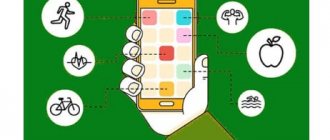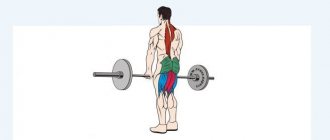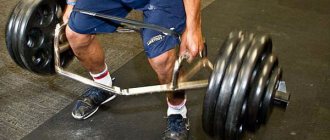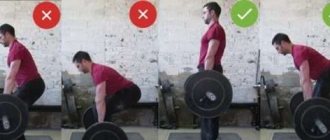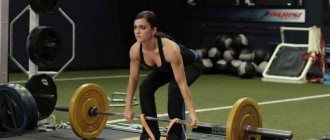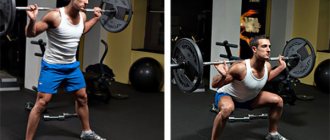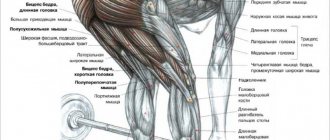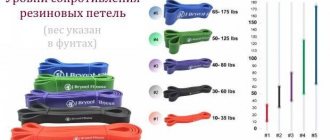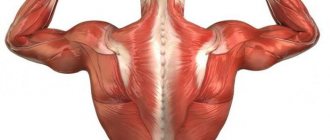Greetings, aspiring athletes and bodybuilders! The desire to qualitatively pump up your body and highlight the relief brought you to me today. Using my extensive experience in professional sports, I will reveal the secrets of gaining overall muscle mass, namely, performing the sumo deadlift exercise.
Let us analyze in detail what kind of complex this is, and what muscle groups are involved when performing it, what benefits and harm it can cause to the body, and we will also analyze the correct technique for performing it. A bonus for you, especially from me, is useful advice regarding performing the sumo deadlift - a warm-up complex, the necessary equipment, recommendations for the number of approaches and repetitions, as well as useful information about the categories of sports nutrition to achieve the maximum effect from training.
What kind of exercise is this
The deadlift is one of the best exercises for gaining overall muscle mass. Beginners to the sport unreasonably consider its implementation too dangerous and difficult, so the priority is complexes for the chest and biceps muscles. In part, these fears are true. Doing the exercise incorrectly can lead to dangerous back injuries.
The sumo deadlift is aimed at creating strong muscles in the legs and back, without which it is impossible to fully pump up the body. The exercise is included in the basic training complex for bodybuilders. The technique involves lifting the barbell from the floor with legs wide apart to waist level and returning the barbell to its original position.
The complex, in addition to bodybuilding, is used in functional circuit training (trap bar deadlifts), powerlifting and other strength sports. Deadlift contributes to the maximum strength load of athletes and unlocks their potential before great strength records.
What muscles work
In the photo, the bodybuilder’s body relief is impressive! Traction promotes maximum load on the muscle groups of the legs and back. The muscles involved are:
- Gluteal.
- Large round dorsal.
- Lat.
- Trapezoidal.
- Diamond-shaped.
- Spinal extensors.
- Posterior thigh.
During training, the hands and forearms receive additional stress, because they have to hold the barbell suspended. The rectus and oblique abdominal muscles help stabilize the core.
The maximum load is received by the extensor muscles of the spine, namely the lumbar region. Less load is placed on the latissimus dorsi muscles. The hamstrings, glutes and quadriceps begin to work actively. With the classical technique, the gluteal muscles and the back of the thigh receive significantly less load, and therefore are more suitable for the stronger half of humanity.
When performing sumo deadlifts, the load on the muscles of the buttocks and hamstrings significantly increases. Sumo is characterized by increased stress on the inner thighs. During the exercise, the semitransverse and semitendinosus muscles are also involved in the work, together with the deep muscles of the back of the thigh.
Algorithm of actions and main difficulties
- Stand close to the barbell, your shin should almost touch the bar.
- Place your feet turned 45 degrees, wider than your shoulders, almost under the barbell plates.
- Lower yourself into a squat, keeping your back straight and your shins perpendicular to the floor, until you grab the bar with an overhand grip, keeping your arms parallel. Tighten the muscles of your back, abdomen, arms and legs.
- Using your legs and back, trying to press your heels into the floor without rounding your back, slowly, without jerking, lift the barbell, while straightening your legs and standing upright.
- Slowly lower the barbell back down, returning to the starting position. Don't drop the barbell or round your spine.
Since the sumo deadlift is a complex and difficult exercise, performing it incorrectly can result in injury or simply a significant decrease in efficiency.
To avoid this, you need to remember a few common mistakes and not repeat them.
The back should be straight, the muscle corset should be tense. This will develop and strengthen the back muscles without unpleasant consequences for the spine.
You need to lean on your heels. lift the weight not with your shoulders, arms or solely your lower back, but with the combined work of the muscles of your legs and back.
Watch the position of your shins: your knees should not hang over the bar or converge inward
You can adjust the load on your back by positioning your pelvis in the starting position. As you go lower, you transfer some of the effort to your legs.
The barbell does not need to be “bounced” off the floor or, conversely, to finish the repetition with the barbell suspended. The apparatus should slowly fall to the floor at the end of each repetition.
This will make the exercise most effective, since the main effort in the deadlift occurs when lifting the barbell from the floor.
Watch the sumo deadlift technique video to better understand how to prevent injuries and do everything correctly:
Subject to proper execution technique, the sumo deadlift has several important simplifications and advantages over the classic deadlift, while not falling behind it in terms of efficiency.
Therefore, this heavy compound exercise can be an important part of the training program for both the serious beginner and the trained athlete.
The benefits and harms of exercise
Deadlifting involves almost all muscles - legs, back, arms, abs, shoulders, promoting their growth and strengthening. In addition, the central nervous system is strengthened. Advantages of the exercise:
- Actively builds muscle mass.
- Strengthens the back and spinal trunk.
- Actively works on the muscles of the lower extremities and buttocks.
- Increases overall physical strength.
Use light weights to hone your technique.
Contraindications
Contraindications for deadlifts include:
- Injuries of the upper and lower extremities.
- Phlebeurysm.
- Received or congenital spinal injuries.
- Curvature of the spinal column.
- Adolescence.
Expert opinion
Doing deadlifts as a teenager is highly undesirable. Exposure to heavy weights negatively affects the health of the spine, physical growth stops and chronic back diseases appear.
Deadlift in the Sumo technique, features of execution and differences from the classical one
The deadlift is deservedly considered one of the most important basic exercises for bodybuilders. This is a complex exercise that involves many muscle groups and joints. Deadlifts maximize muscle growth by stimulating the production of natural anabolic hormones.
When performing the exercise, the largest muscle areas actively work: the athlete’s legs and back. For bodybuilding beginners, the classic deadlift can be replaced with the sumo version. This will help develop your back muscles not only effectively, but also safely.
How is it different from classical deadlift and Romanian deadlift?
The deadlift can be performed in three variations:
- Classic technique.
- Romanian technology.
- Sumo technique.
The main differences come down to the different posture of the athlete’s body and, accordingly, the redistribution of the load on different muscle groups.
To understand the difference between the sumo deadlift and the other two techniques, first I will tell you about the classic version of the exercise. The classic looks like this: the initial pose of the athlete with the legs positioned hip-width apart (narrow stance).
The bar of the barbell is located as close as possible to the legs, and passes through the center of the feet. In a squat, you grip the bar with straight arms. Place your hands so that your forearms lightly touch the outer edge of your thighs.
The most important point when performing the exercise is the position of the back. Only a straight back is allowed, which should only be slightly arched in the lumbar region. It is important that the spine does not round, otherwise the athlete may cause serious injury to himself.
The position of the pelvis is retracted. The chest is open, the bar of the barbell is located exactly under the line of the shoulder girdle. When performing a sumo deadlift, the position is taken with a wide stance and the grip is between the legs.
The technique for performing the Romanian deadlift is very different. Another name is deadlift. If in the first two types only the position of the legs changed, then this technique completely eliminates the squat behind the barbell. The grip, lifting the weight and returning to the starting position are performed with straight legs. This technique is more suitable for the female half, because it increases the load on the buttocks and back of the thigh.
How to do the Sumo deadlift[edit | edit code]
- Spread your feet wide and lower yourself into a half squat.
- Turn your toes slightly outward and roll the barbell up so that it almost touches your ankles.
- Keeping your back straight, bend over and grab the barbell at shoulder-width apart with an uneven grip.
- Raise your pelvis slightly and tense your arms. This way, you will provide yourself with a rigid “frame”, thanks to which your muscles can contract more efficiently.
- Slowly lift the barbell off the floor and begin to straighten, simultaneously straightening your knees and body.
- Also slowly return the bar to the floor.
Correct technique and types of exercises
Correct technique is the main key to success in sports. The sumo deadlift is performed from the same starting position as the classic deadlift, except for the position of the legs.
To grasp the bar, the body is slowly tilted (40-45 degrees) while bending the legs. The body leans slightly forward, and the pelvis moves back. The shoulders should move strictly along the vertical axis.
The rise begins with a smooth extension of the legs and only then the back straightens. Arms straight. On the rise, the shoulder blades are retracted. Then we gradually lower ourselves - the back bends first (no more than 45 degrees), and then the legs.
This is what the correct technique for performing a sumo deadlift looks like.
To find out your mistakes during execution, you can film the workout and go over the main points with the trainer.
Proper Deadlift Technique
This traction option is not typical. It is rarely seen performed by athletes training in the gym. There are fitness centers where no one practices deadlifts of any variation. For those who make the classic version, which has already become familiar, making sumo will not be a problem.
Deadlift technique (classic and sumo)
Something to remember
Changing the position of your feet changes the muscle groups involved. The unusual position requires caution when lifting weights. Those who are doing this version of the deadlift for the first time should not use the usual weight. It is better to lighten the load to feel the reaction of your own body.
Next, having unloaded the bar, they stand in front of the barbell. Feet are placed shoulder-width apart. This may cause some feeling of tightness and tightness in the inner thighs. Therefore, if you have not done a warm-up, it is better to warm up a little first. You can do several squats from this position. This engages those muscles that will be worked out in the future.
Performance
When the position is accepted, the warm-up is completed, proceed to the exercise:
- Take hold of the barbell, keeping your back straight and level. To grasp the bar, bend at the waist. The grip is similar to the classic version, when the hands are approximately the same width as the shoulders. There are no strict requirements for grip. A wide variety of variations can be used. It all depends on preference and your own convenience. Use an underhand grip, an overhand grip, or a different grip. Experimentation is acceptable.
- They lower, slightly bending the body. Since the legs are set wide, the thighs are almost parallel to the surface of the floor. It is imperative to ensure that your back is completely straight, your chest, like your gaze, is directed forward. Most of the weight lifted is in the back of the legs. Straighten with an explosive, sharp movement carried out by pushing off the legs. The bottom line is that the athlete only holds on to the bar, and the pushing of the projectile is carried out exclusively by the lower part of the body.
At the moment when the bar crosses the knees, the pelvis is pushed forward, the shoulder blades are brought together. Thanks to this movement, the shoulder girdle becomes more elastic. To increase the load and use the shoulders to the maximum, they linger at this point, keeping the shoulder blades retracted, and only then return to the starting position. You always need to control the position of your torso while lowering the projectile. When the bar is down again, it is raised and everything is repeated from the very beginning.
Example workout
For training, you can perform exercises both in the gym with a barbell and at home, for example with dumbbells, which take up much less space.
At home
You can train at home according to the following scheme:
- We take the starting position with dumbbells in our hands at our sides. We go down according to the rules. You can use any comfortable weight and perform 4 sets with the number of repetitions from 15 to 20.
- Starting position with dumbbells below in front of you. A squat is performed to the middle of the shin. Monitor the position of your back and the deflection of the lumbar spine. Also 4 approaches and the number of repetitions from 15 to 20.
The main disadvantage is the lack of weight. But it’s enough to start training, after which you can move to the gym.
In the gym
In the gym, training can be carried out in several ways:
- Full range of repetitions – a certain range of repetitions to achieve a specific goal (for bodybuilders).
- From plinths - the bar is installed on a hill (about 10 centimeters below the knees), significantly removing the load from the back and allowing you to take on more weight.
- From the pit - the athlete rises to a small hill (a stable pallet), putting more strain on his back and legs (depending on the technique).
Training Tips
A coach will help you achieve good results in sports. He can promptly point out possible errors and correct them in a timely manner.
Warm-up
The warm-up begins with an empty bar to warm up the muscles. After completing 10-15 repetitions, you can put on plates, gradually increasing the weight. Number of approaches: 3-4 times, 6-8 repetitions.
Equipment
To perform deadlifts, professionals use special equipment. Is it necessary for beginners? In the exercise, it is not the weight lifted that is important, but the correct execution of the complex. Using belts and a belt is not at all necessary if you do not strive to become a champion in the number of kilograms lifted. The equipment makes it easier to hold a lot of weight in your hands. But pay special attention to shoes. The best models have the thinnest soles. It does not absorb shock and it will be much easier to tear the bar off the floor due to the shortening of the amplitude.
Weight
The weight of the burden is added gradually. You should start with a small comfortable weight, increasing the load over time. Muscles must adapt, otherwise a sudden increase in load will lead to serious injuries, even if there is nothing to indicate future problems on the day of training.
Sets and reps
In different strength sports, the number of approaches and repetitions is calculated according to a specific program. Beginner athletes are limited to one workout per week, 3-4 sets with repetitions 6-8 times and a weight of 50% of the maximum.
More advanced athletes, when working for strength, perform from 3 to 6 approaches of 4-6 repetitions with 90% of the weight of the one-time maximum, and when working for mass - 4-5 approaches of 8-12 repetitions and a working weight of 60-65% of the one-time maximum maximum.
Nutrition and sports supplements
Proper nutrition is important in sports. It must be correct and balanced. A calorie deficit will not result in active muscle growth.
Sports nutrition today is becoming increasingly popular, both among professionals and beginners.
Particular attention should be paid to supplements, such as protein, gainers, protein shakes. They ensure optimal muscle growth with regular exercise in the gym.
How to increase your sumo deadlift
To lift more weight on the barbell when performing the sumo technique, you need to give the barbell a certain acceleration. To do this, it is worth training the explosive strength of the leg muscles using special exercises (squatting on a bench with a delay in the lower position, long jumps, jumping onto a box). At the same time we strengthen our back. The following complexes are suitable: slopes with a barbell or shrugs with dumbbells.
Six Techniques to Improve Your Sumo Deadlift
Find your position
Turn your knees out slightly so that they are in line with your shins. Experienced athletes can place their feet very wide, but most people do better with a moderate width. In the sumo deadlift, the hardest part is the initial moment of the movement, while the top point of the amplitude is much easier, so don’t spread your legs so wide that you can’t even lift the barbell off the floor.
Spread your socks apart
You, of course, do not want to keep your toes apart like a duck all the time, because then it will be quite difficult to develop the necessary force, however, you also cannot leave your toes in a strictly straight position, since this will force you to place the barbell an extra couple of centimeters from your legs (and the exercise will become even more difficult). If you spread your toes out a little, you can position the barbell in such a way that it can easily slide along the inside of your shin. This will allow you to keep the barbell closer to your body throughout the movement, making the overall movement softer and the amplitude shorter.
Keep your groin away from the barbell
Leg length and stretch determine how low of a seat you can start from. You don't want to do "squats" with the weight, but you still try to keep your hips as close to the bar as possible to improve leverage. The best examples of performing this movement correctly are Dan Greene and Caitlin Troth; Both have fairly short legs and excellent stretch, so they can sit very low without their knees “pushing” forward (if their knees are too forward, this results in the bar being “in front” of you, so thereby forcing you to take an unfavorable starting position). The key to good technique here is to sit as low as possible, but so that your back remains straight, and this requires a good stretch of the calf muscles.
Keep your body behind the bar
Once you have determined the starting position of your hips, it is important to adjust the position of your entire body behind the bar. If most of your body is above and in front of the bar, then it will be more difficult for you to “switch off” at the joints at the final point of the amplitude. If your chest and head are in front of the bar, it will be extremely difficult to successfully complete the deadlift. To help yourself take the correct position behind the bar, just sit low from the very beginning, and then begin to pull the bar towards you. This will additionally “turn on” the lateral muscles and prevent injury to the upper spine, and will also prevent premature extension at the hips.
Do a stretch on the floor
Stretching on the floor is essential for getting weight off the floor. This will maintain the necessary muscle tension in the hips and help with the initial movement of the bar. Typically the hardest part of a sumo row is the initial lifting of the bar off the floor, so you'll need to be patient and try to develop as much force as possible to get those plates off the floor. It is also important for you to extend your knees in time so that the bar does not hit them as you move towards their “off” point. Isometric stretching exercises are great for the above purposes. Caitlin Trot does them regularly, and if you're wondering why you should listen to a girl, she holds the world record for squats in the 55kg category - 177kg, and in the sumo deadlift she lifted more than 174 kg!
Get your hips off!
In powerlifting, when performing a deadlift, you must stand straight at the end point, with your hips and knees “off.” And if so, then it is very important to smoothly extend the hips so that this “switching off” goes smoothly. Even if you're not a powerlifter, this will help you maintain a healthy lower back and teach you proper hip movement. People often make the mistake of arching too much backwards at the lower back, which causes hyperextension in the hip joints.
Exercises that involve hip extension, such as lat pulldowns, Romanian deadlifts, good mornings, and barbell lumbar hip extensions while lying on the floor or on a bench (emphasis on the glutes ), will help strengthen the “off” position in the hip joints, which is useful when performing any type of deadlift.
Summarizing the above
You can use sumo deadlifts as the main exercise on the hardest day of training or, conversely, as an additional exercise to the main training program.
An example of a “heavy” day of training with max reps
- A. Deadlifts in competition technique - single repetitions with a weight up to 90% of 1RM (or the estimated weight that you will enter during the next competition)
- B. Partial 3x3 sumo row. Raise the barbell 7.5 cm from the floor.
- C. Assistive exercises for the lower body: for the glutes, calves, abs, quadriceps, etc.
Example of a dynamic workout
- A. Box squats with 10x2 bands with a weight of 60%
- B. Sumo row with 6x2 chains with a weight of 50% of 1MP. Then 2x2 with a weight of 65% of 1MP.
- C. Assistive exercises for the glutes, calves, abs, quadriceps, etc.
An example of a “volume” day – “Powerlifting Party”
- A. 5x3 Competitive Deadlift
- B. Sumo deadlift “out of the pit” 4x6
- C. Deadlift with straight legs 3x10
Since adding sumo deadlifts to my program in 2010, I have added 57kg to my max attempt. The classic deadlift increased from 233 to 265 kg, and the sumo deadlift at competitions increased from an average of 180 to 290 kg. This was my first competition lift of more than 290 kg. And this was the best and fastest deadlift attempt that day in terms of the speed of lifting the barbell, although I was already at 290 kg in the third attempt.
It took me a few years to get it right, but now the deadlift weights are creeping back up and I know that with the right training regimen, I'll soon be deadlifting 295kg. And if so, then I suggest you give sumo deadlift a chance, even if in the past the relationship with it, so to speak, did not work out. It may not be your favorite deadlift, but it will help you improve your squat and deadlift performance, break plateaus, and achieve new bodybuilding results.
Common mistakes
Even with regular training, there may be no results. It's all about the mistakes of novice athletes. What could they be?
- Stretching. Deadlifting requires a good stretch in the hamstrings. Lack of flexibility can lead to poor positioning and subsequent injury. Muscle stretching should be taken care of in advance.
- Neck position. If the barbell is too far from your feet, lifting it from this position can injure your back because it is very difficult to maintain balance in this position.
- Width of feet. If stretching is very difficult, you should not try to overload your legs by spreading them wider than a comfortable position. At the moment of jerking, the tendons can be seriously injured.
- Training frequency. You won’t be able to gain muscle gain in one month, and therefore you need to train according to your schedule. Athletes only need one workout a week, or two at most, alternating deadlifts with dumbbells. Frequent training, especially with heavy weights, puts a lot of stress on the tendons, which require time to recover. Otherwise, training may end in failure.
- Let's breathe. Particular importance during training is given to correct breathing. Only uniform breathing without delays. Movements are smooth, without sudden jerks.
